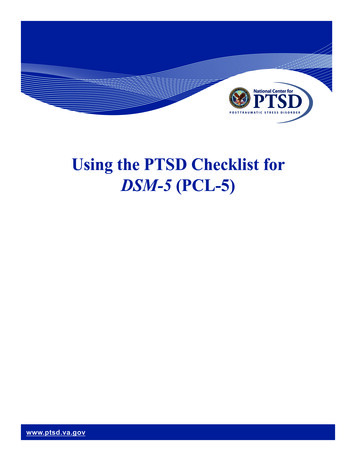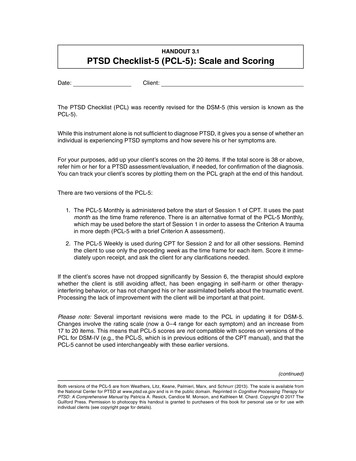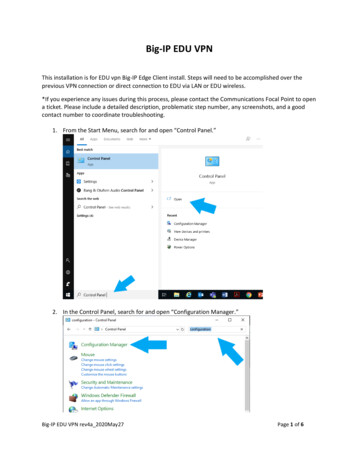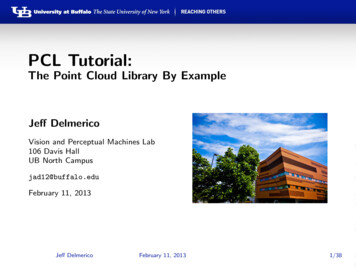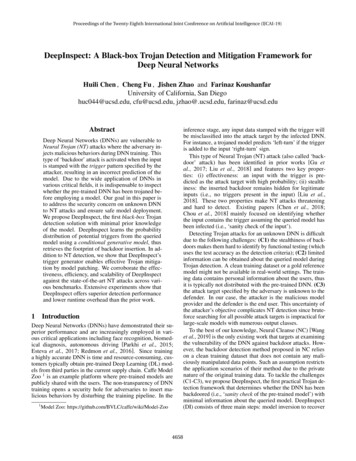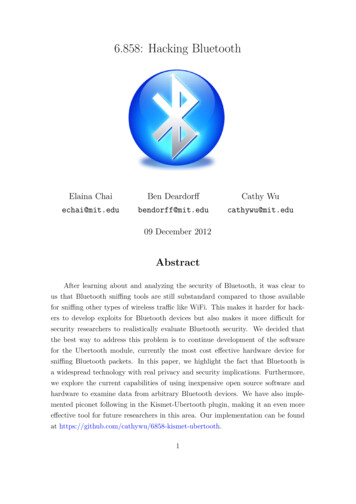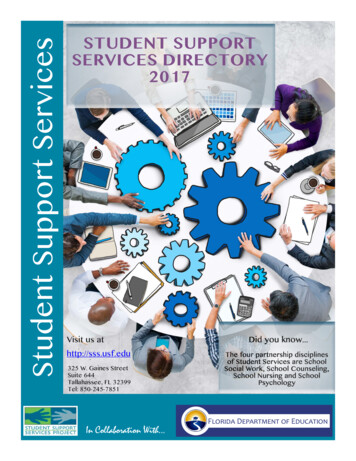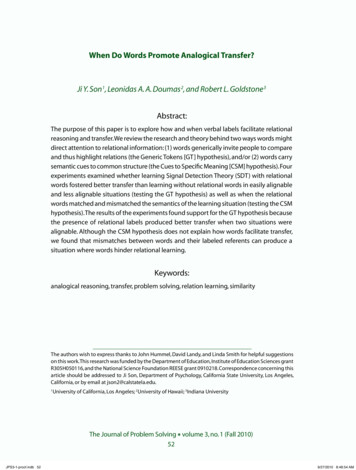
Transcription
When Do Words Promote Analogical Transfer?Ji Y. Son 1, Leonidas A. A. Doumas 2, and Robert L. Goldstone 3Abstract:The purpose of this paper is to explore how and when verbal labels facilitate relationalreasoning and transfer. We review the research and theory behind two ways words mightdirect attention to relational information: (1) words generically invite people to compareand thus highlight relations (the Generic Tokens [GT] hypothesis), and/or (2) words carrysemantic cues to common structure (the Cues to Specific Meaning [CSM] hypothesis). Fourexperiments examined whether learning Signal Detection Theory (SDT) with relationalwords fostered better transfer than learning without relational words in easily alignableand less alignable situations (testing the GT hypothesis) as well as when the relationalwords matched and mismatched the semantics of the learning situation (testing the CSMhypothesis). The results of the experiments found support for the GT hypothesis becausethe presence of relational labels produced better transfer when two situations werealignable. Although the CSM hypothesis does not explain how words facilitate transfer,we found that mismatches between words and their labeled referents can produce asituation where words hinder relational learning.Keywords:analogical reasoning, transfer, problem solving, relation learning, similarityThe authors wish to express thanks to John Hummel, David Landy, and Linda Smith for helpful suggestionson this work. This research was funded by the Department of Education, Institute of Education Sciences grantR305H050116, and the National Science Foundation REESE grant 0910218. Correspondence concerning thisarticle should be addressed to Ji Son, Department of Psychology, California State University, Los Angeles,California, or by email at json2@calstatela.edu.1University of California, Los Angeles; 2University of Hawaii; 3Indiana UniversityThe Journal of Problem Solving volume 3, no. 1 (Fall 2010)52JPS3-1-proof.indb 529/27/2010 8:48:54 AM
When Do Words Promote Analogical Transfer?53Although there is much debate on the connection between language and thought (e.g.,Whorf, 1956; Gumperz & Levinson, 1991; see Gentner & Goldin-Meadow, 2003 for a review),there is general agreement that words are useful for learning new concepts. For example,even when words and meanings are unknown, as is the case with very young children orwith the use of novel words, linguistic labels facilitate learning (e.g., Lupyan, Rakison, &McClelland, 2007). Research with young children has shown that words facilitate categorylearning more than non-linguistic cues (Balaban & Waxman, 1997; Waxman & Booth, 2003;Waxman & Markow, 1995). In addition, adults show faster learning and more robust retention when novel categories are associated with linguistic labels relative to non-linguisticcues (Lupyan, 2008).To date, a great deal of work has focused on the general phenomenon of the usefulness of words in learning situations, but comparatively little empirical work has focusedon the reason for this usefulness. What makes words so useful in learning contexts?Relational reasoning—reasoning based on the relations between objects or featuresof objects—is a rich domain for looking at potential cognitive benefits of words becauseit is a highly demanding cognitive skill and many studies have shown that words makethe task of relational reasoning easier. Relational thinking plays a central role in humancognition. It underlies our ability to perceive and understand the spatial relations amongan object’s parts (Hummel, 2000; Hummel & Biederman, 1992; Hummel & Stankewicz,1996), comprehend arrangements of objects in scenes (Green & Hummel, 2006; Markman& Gentner, 1993; Richland, Morrison, & Holyoak, 2006), and comprehend abstract analogies between otherwise very different situations or systems of knowledge (e.g., betweenthe structure of the solar system and the structure of the atom; Gentner, 1983; Gick &Holyoak, 1980, 1983; Holyoak & Thagard, 1995). However, despite its centrality in humancognition, relational thinking is cognitively demanding. In contrast to simpler reasoningabout object features or single objects, reasoning about relations requires more workingmemory and makes greater demands on attention (e.g., Halford, Wilson, & Phillips, 1998;Hummel & Holyoak, 1997).There are at least two reasons for the greater cognitive demands of relational thinking. First, relations are properties that hold over collections of objects rather than singleobjects in isolation (Doumas, Hummel, & Sandhofer, 2008). The relation same-shape (x, y),for instance, is a property of any two objects with the same shape, but not of any specificx or y. Two identical shoes are the same-shape in exactly the same way that two trianglesare the same-shape, although same-shape is not a feature of either any single shoe or anyspecific triangle. If one of the identical shoes were paired with a cup, the sameness relationwould disappear. By contrast, an object property such as color remains a property of anobject whether it is paired with a green object or another red object. Because relationsare less spatially and temporally stable than the features of single objects, they are easilyovershadowed by more salient object features such as a color. Even highly perceptual volume 3, no. 1 (Fall 2010)JPS3-1-proof.indb 539/27/2010 8:48:54 AM
54Ji Y. Son, Leonidas A. A. Doumas, and Robert L. Goldstonerelations such as spatial relations (e.g., above, in, under; Loewenstein & Gentner, 2005) areless stable than featural qualities (e.g., has a star on it).Second, relational reasoning is cognitively demanding because representing structure is complex (Doumas & Hummel, 2005; Doumas et al., 2008; Gentner, 1983; Hummel &Holyoak, 1997, 2003). It requires representing (1) the relation and (2) the objects involvedin the relation independently of one another, and (3) the bindings of these objects toparticular relational roles (Doumas & Hummel, 2005). For example, representing the relation bigger (shoe, cup) requires representing the relation bigger and the two objects, theshoe and cup, independently of one another. Consequently, we understand that in theexpression bigger (shoe, cup), the shoe is larger and the cup is smaller, and that in the expression bigger (cup, shoe), the same elements play the opposite roles (the cup is largerand the shoe is smaller).The structure inherent in mental representations makes them very powerful for thepurposes of reasoning (e.g., Doumas et al., 2008; Hummel & Holyoak, 2003), but this powercomes at a cost. Considerable empirical evidence indicates that adults process concretefeatures and concrete categories faster than relational ones (Gentner & Kurtz, 2005; Kurtz& Gentner, 2001) and relational categories seem to be acquired later in development aswell (Hall & Waxman, 1993; Keil & Batterman, 1984; Smith, Rattermann, & Sera, 1988).Studies that show how relational language enables relational reasoning typicallycome from developmental research. These studies often teach children relational categories with or without linguistic labels and then test for generalization. For example,in a series of studies Kotovsky and Gentner (1996) investigated how labels affectedfour-year-old children’s sensitivity to relations such as symmetry and monotonicity. InKotovsky and Gentner’s studies, children were taught triads of shapes in a symmetric(i.e., xXx) or monotonically increasing pattern (i.e., xXX). The symmetric cards werecalled “even” and the increasing cards were called “more-and-more.” Then, childrenwere asked to determine which of two triads was the best match to a target triad,where the best match involved relations with different dimensions (e.g., a size-basedpattern of xXx matched black-white-black) or different dimension values (e.g., xXx toOoO). Children who learned the relational labels were able to make relational choicesmore frequently than children who did not. Kotovsky and Gentner (1996) suggest thatacquiring a word for the xXx-patterned triads allowed children to notice the relationalsimilarities among them.Often experiments regarding words and relational reasoning are designed to demonstrate that words facilitate relational reasoning but they do not allow us to distinguishbetween different ways words might help. By one account, favored by Kotovsky andGentner (1996), the word “even” cues children to compare different triads and to extract thesubtle relational similarity, thus directing their attention. However, there is an alternativepossibility that the labels “even” and “more-and-more” help direct attention by virtue ofThe Journal of Problem Solving JPS3-1-proof.indb 549/27/2010 8:48:55 AM
When Do Words Promote Analogical Transfer?55their semantics. Perhaps the meanings of these labels, more than the mere act of givingcommon labels to situations, helps children attend to relational information over othersources of similarity. By this account, “even” suggests balance or symmetry, which allowsthis aspect of “xXx” to be emphasized.The purpose of this paper is to explore how and when verbal labels facilitate relationalreasoning. First, we review the research and theory behind two ways words might directattention to relational information: (1) words invite learners to compare, highlight, andrepresent relations (the Generic Tokens [GT] hypothesis), and/or (2) words carry semanticcues to common structure (the Cues to Specific Meaning [CSM] hypothesis). Given thesetwo (non-mutually exclusive) possibilities, we can make predictions about when wordsboost relational learning. Four experiments examine these predictions.Words as Generic Tokens (GTs) to Represent Difficult ConceptsWe have already discussed how relations are difficult to process because they requiremore representational capacity and more processing resources than simple objects inisolation. The crux of the GT theory is that associating a simple symbol (i.e., a word) witha complex situation (i.e., a relation) might make it easier to access or think about thesituation. Linguistic labels, and other useful symbols, are typically stable across contextsbecause they are relatively unchanged by idiosyncratic differences in context (e.g., tokensof the word “dog” said at different times are highly similar) and are non-iconic to theirreferents (e.g., the word “dog” does not particularly look like a dog). Because words enjoythe combination of being relatively context-free and non-iconic, their GT qualities allowthem to stand for potentially subtle relations. When relations are tied to an object-likeword, they might seem more concrete. However, it is important to note that this function of words does not necessitate that all word and language processing is inherentlysymbolic and propositional. In fact, there are theories about the mechanism of languageprocessing (e.g., Elman, 1995) that suggest that language has the appearance of beingsymbolic and context-free even though the underlying mechanism may be dynamic,continuous, and sensitive to context in real-time (see also Clark, 1998; Dennett, 1991;Spivey, 2007).Words as GTs may stabilize highly variable perceptual experiences—a function particularly useful in learning relational concepts. Having the same label for similar relationscan implicitly induce comparison (Brown, 1958; Gentner & Namy, 2004; Namy, 2001), apowerful mechanism for structural abstraction (Dixon & Bangert, 2004; Doumas & Hummel,2005; Doumas et al., 2008; Gentner, 2005; Gentner & Namy, 1999; Gick & Holyoak, 1983).Symbolic juxtaposition (Gentner & Medina, 1998)—applying the same word to differentinstances—is a natural cue to compare instances partly because of our conventional andubiquitous practice of labeling categories. volume 3, no. 1 (Fall 2010)JPS3-1-proof.indb 559/27/2010 8:48:55 AM
56Ji Y. Son, Leonidas A. A. Doumas, and Robert L. GoldstoneAlthough symbolic juxtaposition might suggest that words are only effective whenapplied to multiple situations, even having one labeled instance may be effective becauseof our general convention of labeling concepts/categories. Some might consider that thevery existence of a word implies the existence of a category/concept (Quine, 1960) andindeed cross-cultural research has suggested that concepts such as exact numerosity (Picaet al., 2004) or particular spatial categories (Bowerman & Choi, 2003) are used and acquiredbecause of the arbitrary labels that stand for these ideas. Even cases of limited “language”training, such as laboratory-raised nonhuman primates, suggest that understanding numerosity (Boysen & Bernston, 1989) and relational similarity (Thompson & Oden, 1993;Thompson, Oden, & Boysen, 1997) are mediated by symbolic tokens.Comparison may drive the discovery of relational similarity but words provide stabletokens to represent any newly discovered similarities. In other words, once acquired, wordsprovide a new level of object-like computation over the actual relations (Clark, 1998). Support for this generic function of words comes from Richard Catrambone’s research on howwords seem to help novices chunk newly learned procedures into meaningful and betterremembered groups (Catrambone, 1996, 1998). Also, separate words applied to subtly different objects help differentiate objects that are difficult to discriminate (Goldstone, 1994).These results suggest that words have generic properties, apart from their meanings, thatmay foster more efficient encoding and categorization.Words as Cues with Specific Meanings (CSM)Thinking about words as generic tokens places the emphasis on the ability of words toefficiently capture complex ideas and make manipulation of these ideas easier. However,language probably derives much of its power from connections to real experiences. Whenknown words are used, children also seem to show consistent benefits in detecting relational similarities. An experiment reported by Rattermann and Gentner (1998) showedthat brief training with known words significantly increased relational responding inchildren compared to children who did not receive word training. In their task where toddlers could make matches by relative size similarity or object similarity, children typicallymade object matches. However, when objects were named with labels that children ofthis age spontaneously use to mark monotonic size changes (e.g., daddy, mommy, baby),children were able to make relational matches. However, this benefit was not found whenobjects were labeled with arbitrary words (jiggy, gimli, fantan). This result indicates thatassociations between words and past experiences significantly influence whether wordscan highlight relations. Likewise, Loewenstein and Gentner (2005) found that some setsof words promote relational responding more effectively than others. Labeling locationsin a three-tiered box as {top, middle, bottom} promoted children’s ability to use spatialinformation more effectively than the labels {on, in, under}. Both studies suggest that theThe Journal of Problem Solving JPS3-1-proof.indb 569/27/2010 8:48:55 AM
When Do Words Promote Analogical Transfer?57specific content of the words, or the relational framework they invoke, matters for providing cognitive benefits.As GTs, mommy and jiggy are essentially equivalent (both are equally good symbolictokens). However, if words are thought of as CSMs, not all words are predicted to be equallybeneficial. The fact that mommy works well as a relational label may be the consequenceof mommy having rich associations to experiences that suggest medium size (especially inthe context of daddy and baby). However, the acquisition of relational meanings is not atall straightforward. Hall and Waxman (1993) have attempted to teach children a relationalword by providing a definition. They taught children an arbitrary word, murvil (with theequivalent meaning as the word “passenger”), and even defined it for them (i.e. “This isa murvil because it is riding in a car”). Despite the provision of a relational word and anexplicitly relational definition, children were not able to learn that murvils are any and alldolls that sit in cars. Instead, children interpret the label murvil as the name of dolls thatlook like the doll that was named.This suggests that it is not only difficult to learn the murvilcategory (how to generalize the label) but also to learn the explicitly provided relationalconcept. Because of the label’s lack of rich associations to other words and experiences,there is no relational benefit from using an arbitrarily defined word.There might be a continuum of words (and their meanings) from semantically empty(i.e., jiggy, murvil) to semantically rich and matching the referent (e.g., daddy to refer tosomething large) and some in between (e.g., semantically rich but not matching, such asusing the word daddy to refer to something small). We focus our research (with adults)on the semantically meaningful end of the spectrum, looking at semantically meaningfulwords that can either match or mismatch their referents. Semantically mismatching wordsmay be a better control for matching words since they control for the meaningfulness, butnot the appropriateness, of the label. Also, it is possible that there are additional memorydemands from having to learn a nonsense term like jiggy.Rationale of ExperimentsThe majority of the experiments reviewed above illustrate difficulties that children havewith relational similarity, but even for adult learners, novel abstract relations are difficult toacquire (e.g., Goldstone & Sakamoto, 2003). This paper examines the dual role of words, asGTs and CSMs, in adult relational reasoning in order to test how linguistic labels can affectrelational reasoning. Our central question concerns how and when words confer benefitsin relational reasoning. Is it because labels act as GTs that are easier to manipulate andremember than entire relational systems? Or, is it because the specific semantic contentof the words provides clues to a situation’s underlying relational structure? We conductedfour experiments to investigate how words confer benefits in relational reasoning. In eachexperiment, participants were presented with a tutorial, a corresponding tutorial quiz volume 3, no. 1 (Fall 2010)JPS3-1-proof.indb 579/27/2010 8:48:55 AM
58Ji Y. Son, Leonidas A. A. Doumas, and Robert L. Goldstonefollowed by a structurally similar transfer situation and a corresponding transfer quiz. Eachexperiment tested two conditions: a Word condition with relational labels included in thetutorial situation, and a Control condition without those labels.The behavior of interest was the ability of learners to utilize relational knowledgefrom the tutorial situation in a new transfer context. The underlying system of relationsthat participants learned and transferred was Signal Detection Theory (SDT). SDT is a wayof understanding decision making that involves uncertainty. Typically an SDT situationinvolves some sort of evidence upon which a categorical decision is made, the decisionitself (e.g., “yes/no,” “in/out,” “healthy/sick,” “signal/noise”), and the actual status of thedecided entity (whether it was actually signal or noise). Although the evidence is informative as to whether something is signal or noise, it is often imperfect so the decision hassome uncertainty. Under these conditions, there are ways to maximize the likelihood ofmaking hits (deciding “signal” when the signal is actually present) and minimizing falsealarms (deciding “signal” when the signal is not present). A parallel expression of the sameidea is to maximize correct rejections (deciding “noise” when signal is not present) andminimizing misses (deciding “noise” when the signal is actually present). SDT provides aninformative framework for understanding a variety of decision-making situations underuncertainty. The relational words that we used were: evidence, target (signal), distracter(noise), hit, miss, correct rejection, and false alarm. We did not use the traditional SDT termssignal and noise because those are grounded in the historical development of SDT that isprobably not intuitive to our participants.We crossed two aspects of similarity in order to test the effects of GTs and CSMs aswell as their interactions. If words are GTs that represent relations efficiently, then regardless of the semantics of the relational labels, they should provide a benefit. Especially whenworking together with comparison (Doumas et al., 2008; Markman & Gentner, 1993) todrive the discovery of relational similarity, the presence of GTs that can represent theseextracted relations may be beneficial. More alignable (relationally comparable) SDTstories will benefit from GTs more than less alignable SDT stories. To test this prediction,Experiments 1 and 2 used tutorial and transfer situations that were more alignable andExperiments 3 and 4 contained situations that were less alignable (see the columns ofTable 1). If the generic properties of words work together with useful comparisons, thenalignable and thus more comparable stories should show an advantage to learning withrelational words (Experiments 1 and 2).However, if the CSM aspect of words is critical for directing attention to relations, thesimilarity of words’ meanings to the referents in the story should also modulate relationallearning. To test this prediction, Experiments 1 and 3 had greater similarity and Experiments 2 and 4 had less similarity between the relational words and the story elementsthey referenced (see the rows of Table 1). Given that the relational label target (especiallyin contrast to distracter) is a positive term, Experiments 1 and 3 paired it with a positiveThe Journal of Problem Solving JPS3-1-proof.indb 589/27/2010 8:48:56 AM
When Do Words Promote Analogical Transfer?59Table 1The overall design of the four experiments was created by manipulating whether therelational words semantically align with the tutorial (rows) and whether the tutorial storysemantically aligns with the transfer story (columns). Positive target means that the SDTtarget in the story is semantically positive, such as healthy athlete or sweet melon. Negative target means that the referred element is negative, such as sick patient or infectedmelon.Stories alignStories do not alignRelational words semanticallyoverlap with tutorial elementsExperiment 1Positive target tutorialPositive target transferExperiment 3Positive target tutorialNegative target transferRelational words do notsemantically overlapExperiment 2Negative target tutorialNegative target transferExperiment 4Negative target tutorialPositive target transferelement in the tutorial situation (healthy athletes) while distracter was paired with thecorresponding negative element (unhealthy athletes) so that the relational labels weresemantically aligned with the story elements. Even though positivity could be construedas a superficial feature, it may provide a semantic clue toward the relational structure. Bycontrast, in Experiments 2 and 4 the positive label target referenced a negative story element (sick patient) while the negative label distracter referenced a positive story element(healthy patient). Table 2 shows the complete set of relational labels aligned with theirintended referents in the tutorial and transfer stories. If the semantic overlap betweenrelational words and their referents during learning is important, we should see greaterbenefits of relational words in Experiments 1 and 3. A semantic mismatch between relational labels and their referents might also lead to a deleterious influence of relationalwords in Experiment 2 and 4.We used three different measures: a learning quiz to test whether words have anyimpact on initial learning, a transfer quiz to test appreciation of the implicit relationalsimilarities between tutorial and transfer stories, and an analogy quiz (matching correspondences between story contexts) to see if subjects can explicitly make connectionsbetween the simulations.Experiment 1The conditions of Experiment 1 provide the best chances of producing a benefit for learning with relational words because this experiment provides both semantic alignmentbetween tutorial and transfer elements as well as semantic overlap between the relationallabels and their tutorial referents. volume 3, no. 1 (Fall 2010)JPS3-1-proof.indb 599/27/2010 8:48:56 AM
60Ji Y. Son, Leonidas A. A. Doumas, and Robert L. GoldstoneTable 2Table 2 presents the relational labels with their story referents from all four experiments.Participants in the Word conditions were presented with a tutorial that included both therelational labels and story referents while corresponding Control tutorials only presentedthe story referents. There were no relational labels in any of the transfer contexts.Relational Labels(Explicitly presented in theWord condition tutorial)Positive Target Tutorial(Exp. 1 & 3)Negative Target Tutorial(Exp. 2 & 4)TargetHealthy athleteSick patientDistracterUnhealthy athleteHealthy patientEvidenceCell strengthCell distortionHitHealthy diagnosed “healthy”Sick diagnosed “sick”MissHealthy diagnosed “unhealthy”Sick diagnosed “healthy”False alarmUnhealthy diagnosed “healthy”Healthy diagnosed “sick”Correct rejectionUnhealthy diagnosed“unhealthy”Healthy diagnosed “healthy”(None of these labels werepresented in transfer)Positive Target Transfer(Exp. 1 & 4)Negative Target Transfer(Exp. 2 & 3)TargetSweet melonInfected melonDistracterBitter melonNormal melonEvidenceMelon weightMelon weightHitSweet melon exportedInfected melon sent to analysiscenterMissSweet melon rejectedInfected melon soldFalse alarmBitter melon exportedNormal melon sent to analysiscenterCorrect rejectionBitter melon rejectedNormal melon soldMethodParticipants and DesignEighty-seven undergraduates from Indiana University participated in this experiment forcredit. A computer program randomly assigned half of these participants to be in the Wordcondition (N 44) and the other half were assigned to the Control condition (N 43). Threeadditional participants who took less than 15 minutes to complete the experiment wereexcluded from analysis. When participants were debriefed at the end of the experiment,The Journal of Problem Solving JPS3-1-proof.indb 609/27/2010 8:48:56 AM
When Do Words Promote Analogical Transfer?61they reported how much they previously knew about SDT. All of our participants did notknow it at all or had heard of it but did not know what it was about.Materials and ProcedureAll undergraduates read through a computer-based SDT tutorial made up of pictures andexplanatory text (screenshots are provided in Figure 1; full tutorials and correspondingquizzes from all four experiments are available online, http://www.calstatela.edu/centers/learnlab/sdt). The tutorial was a 47-screen self-paced slide show covering basic SDTconcepts such as the difference between evidence for a decision, the decision, and theactual status of the decided entity (either signal or noise). Students were shown how adecision boundary could lead to two ways of making the right decision (hits and correctrejections) and two ways of being incorrect (misses and false alarms). This was followed bytwo examples where the decision boundary was moved in order to show the relationshipbetween these categories. Additionally, participants were shown what would happen ifthe signal distribution shifted along the evidence continuum.The principles of SDT were embedded in the context of a doctor trying to pick outhealthy athletes to play for the university by examining blood cell strength. In the tutorialstory, athletes with strong cell samples were more likely to be healthy than those withweak cell samples. Although cell strength was an imperfect indicator of health, the doctor tried to optimize his decisions based on this imperfect evidence. The Word conditiondiffered from the Control condition in only one respect: interspersed into the tutorialwere relational labels presented alongside contextual elements. Healthy athletes werelabeled targets and the unhealthy athletes were distracters. Those that the doctor deemed“healthy” were labeled “target” with quotation marks around both the story element andthe relational term indicating that this is only the doctor’s decision rather than the actualstatus of the athlete. Hit, miss, correct rejection, and false alarm were also included in theWord condition’s tutorial. Other than the addition of the labels, the tutorials for the Wordand Control conditions were identical.The tutorial teaches some basic concepts of SDT without using the traditional normal distributions typically used in SDT classes or textbooks because of the limited timeconstraints of the experiment. Pilot experiments teaching students SDT with traditionalnormal distributions contrasted with other attempts using frequency bar graphs supported the claim that frequency information is far easier to understand than probabilityinformation (in both general cognition, Gigerenzer & Hoffrage, 1995, and pedagogy, Bakker & Gravemeijer, 2004). We speculated that the overlapping region of the traditionaldistributions (i.e., where the evidence could be indicative of either targets or distracters;see Figure 1) was particularly crucial for understanding SDT but also particularly confusing for students. Because we were not interested in teaching graph reasoning per se, wedeveloped bar graphs that utilized non-overlapping spaces and color codes tailored to volume 3, no. 1 (Fall 2010)JPS3-1-proof.indb 619/27/2010 8:48:56 AM
62Ji Y. Son, Leonidas A. A. Doumas, and Robert L. Goldstonerepresent critical concepts of SDT (see Figure 1). Non-overlapping regions of the screen(i.e., top and bottom of Figure 1c) were used to represent two different distributions (i.e.,actually healthy and actually unhealthy people). Colored labels (“H” and “U”) provided aperceptua
of the word “dog” said at different times are highly similar) and are non-iconic to their referents (e.g., the word “dog” does not particularly look like a dog). Because words enjoy the combination of being relatively context-free and non-iconic, their GT qualit
